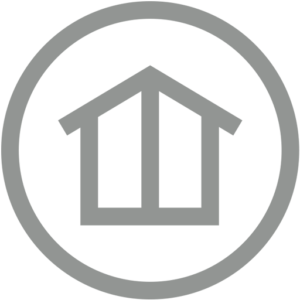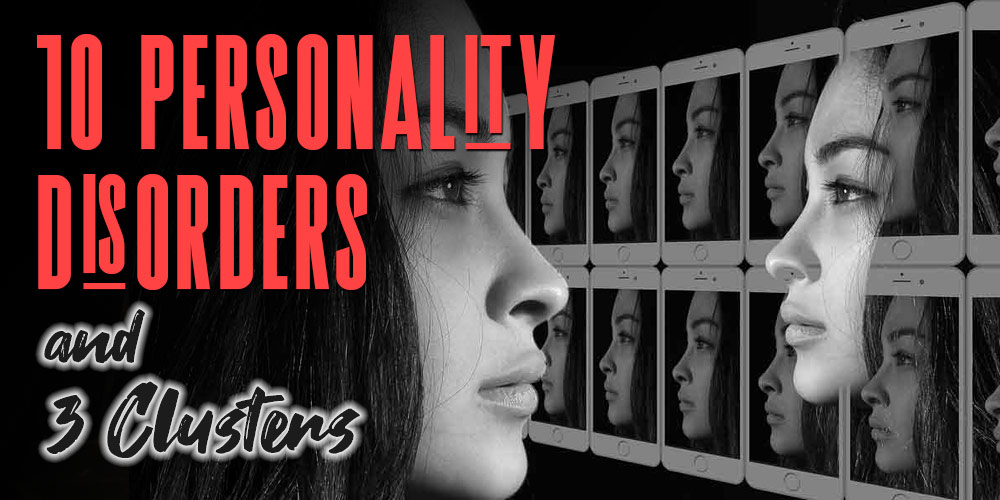
Grouping mental health conditions into categories can make them easier to identify and treat, such as different personality disorder types, which are grouped into 3 personality clusters according to their traits.
The 10 types of personality disorders often overlap with each other and share similar characteristics.
People with this condition may struggle in social settings like work, school, or casual environments and can be incorrectly perceived as being odd or eccentric.
Unfortunately, many people don’t understand that underlying personality disorders may be driving anxious, erratic, or overly emotional behavior.
An estimated 9 percent of adults in the U.S. cope with personality disorders in any given year, according to the National Institute of Mental Health.
What’s more, nearly 85 percent of people with personality disorders also experience other types of mental illness, including substance use addiction.
Many people develop a substance use disorder due to self-medicating the symptoms of depression, anxiety, and other mental health issues.
Understanding the 10 different personality disorder types and 3 personality clusters or groups is useful for seeing past what others might view as awkward or unusual behavior.
What are Personality Disorders?
A personality disorder is a mental health condition that causes inflexible or unhealthy thought patterns and affects the way an individual behaves and functions in everyday settings.
It’s not uncommon for people with personality disorders to perceive their way of thinking as normal and blame others for the challenges they face, or to feel victimized.
Obviously, these feelings, thought patterns, and behaviors can create significant issues in developing or maintaining healthy relationships. They can also cause friction at school, work, or other social settings.
These factors make personality disorders difficult to diagnose because a person may never agree to counseling or treatment. At the same time, if they do seek a diagnosis, they may not accept it as true or real when it’s given.
While a personality disorder tends to develop during the teenage years, it may not be recognizable until later. As a person ages, some of the signs of the disorder may become less pronounced, especially if they have found ways to hide or manage it.
Personality Disorder Types and Clusters
There are different personality disorder types, and the symptoms of one type may overlap with the symptoms of another.
Psychiatrists and mental health experts group personality disorders into 3 separate personality clusters referred to as Cluster A, B, and C.
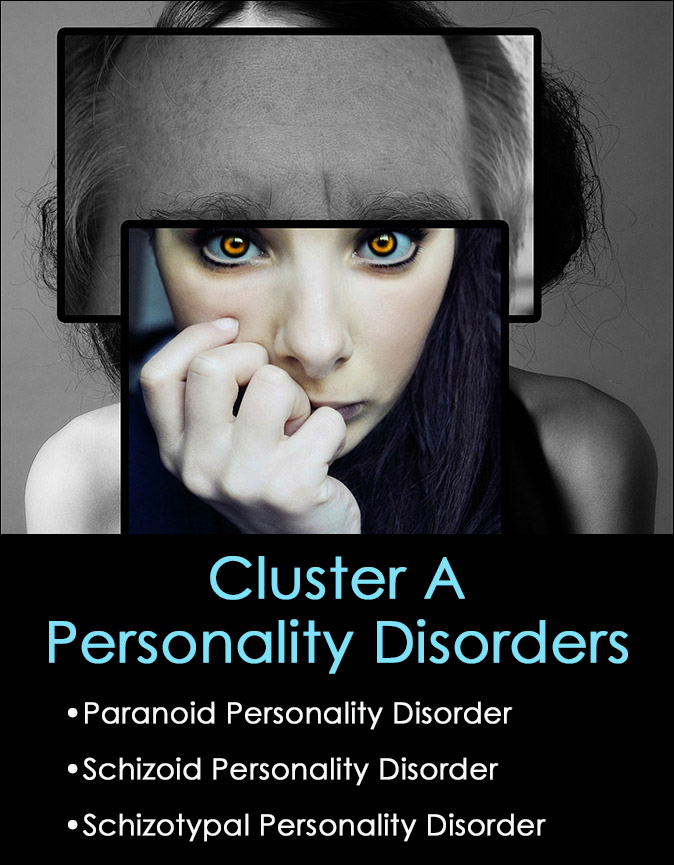
Cluster A Personality Disorders – Odd or Eccentric
Cluster A personality disorders include odd behaviors, thought patterns, and communication that is unconventional or eccentric. Decision-making can be affected by these traits.
The 3 Cluster A personality disorders include:
- Paranoid Personality Disorder
- Schizoid Personality Disorder
- Schizotypal Personality Disorder
Listed below are characteristics and symptoms of Cluster A personality disorders.
Paranoid Personality Disorder
- A reluctance to trust or confide in others out of fear they will use the information against them
- An unreasonable belief that others are trying to sabotage, harm, or lie to them, causing a chronic suspicion of others’ motives or actions
- Perceiving innocent remarks as a personal attack and having an angry or hostile reaction
- Prone to holding unjustified grudges
Schizoid Personality Disorder
- Indifferent or uninterested in other people due to a lack of interest in social or personal relationships
- Difficulty expressing a range of emotions, as well as not picking up on normal social cues from others
- Generally, does not experience pleasure in most activities, including a lack of interest or pleasure in sexual intercourse
Schizotypal Personality Disorder
- Discomfort with close relationships resulting in social anxiety
- Inappropriate or indifferent emotional responses to other people
- Unconventional speech, beliefs, and thinking patterns, as well as peculiar dress and behavior
- “Magical thinking” marked by the belief that casual incidents have secret meanings or that a Schizotypal person’s thoughts can affect another person’s behavior
- Experiencing odd perceptual events, like hearing an invisible voice whisper the person’s name
Of the three Cluster A personality disorder types, Paranoid Personality Disorder is the most vulnerable to mental breakdown symptoms caused by a lack of trust and suspicion of others.
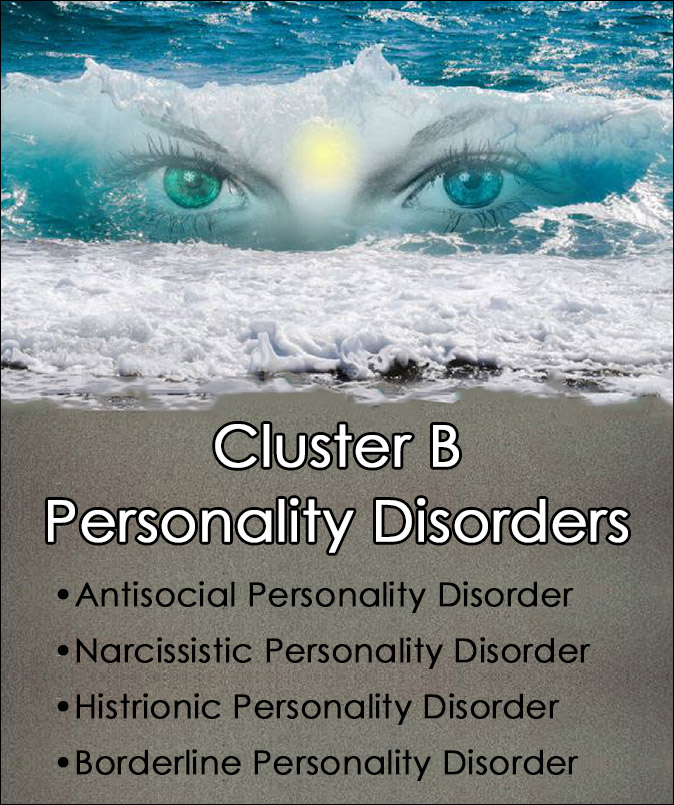
Cluster B Personality Disorders – Dramatic, Emotional, or Erratic
Cluster B personality disorders lean toward dramatic characteristics such as being overly emotional, or severe, erratic, and unpredictable behavior or thinking.
The 4 Cluster B personality disorders include:
- Antisocial Personality Disorder
- Narcissistic Personality Disorder
- Histrionic Personality Disorder
- Borderline Personality Disorder
Below are common symptoms and traits of Cluster B personality disorders.
Antisocial Personality Disorder
- Chronic stealing, lying, and conning others often resulting in persistent trouble with law enforcement
- Impulsive behavior that displays a disregard for the safety of others and oneself
- No regard for the feelings of others and a lack of remorse for bad behavior
- Aggressive and potentially violent tendencies
Narcissistic Personality Disorder
- Arrogant expectation of adoration and constant praise despite the failure to notice the needs and feelings of others
- Jealousy of others or the preconception that others are jealous of you
- Exaggerates past accomplishments, relationships, and abilities
- Convinced they are better than others and have fantasies of great success, power, and influence
Histrionic Personality Disorder (HPD)
- HPD symptoms include attention seeking behavior and being emotionally dramatic, overtly sexual, or delivering strong opinions with few facts
- Highly susceptible to peer-influence
- Overly concerned with physical appearance
- Shallow sense of self and others
- Tendency to believe that relationships with others are deeper or more intimate than in reality
Borderline Personality Disorder (BPD)
- Fragile self-image with tendencies toward mood swings, depression, and suicidal threats or behavior because of interpersonal stress
- Engage in self-destructive and risky behavior like substance abuse, unsafe sex, binge eating, or gambling sprees
- Tendency to have intense and unstable relationships
- Displays of anger, emptiness, or an intense fear abandonment often due to stress-related paranoia
Borderline Personality Disorder should not be mistaken for Bipolar Disorder and it’s important to understand the difference between Bipolar vs BPD symptoms.
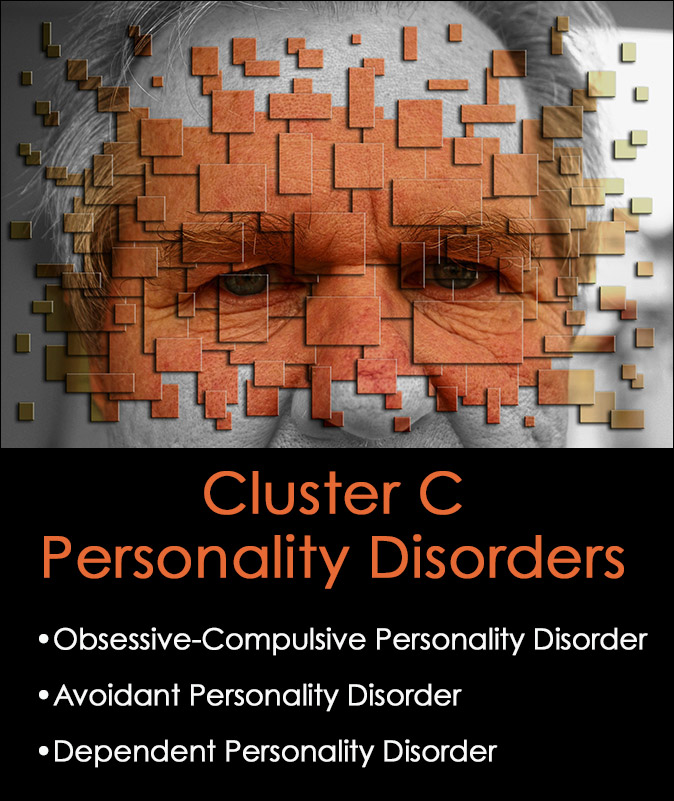
Cluster C Personality Disorders – Anxious or Fearful
Cluster C personality disorders involve patterns of fearful or anxious thinking and behavior. Some symptoms are closely related to different types of anxiety disorders.
The 3 Cluster C personality disorders include:
- Obsessive-Compulsive Personality Disorder
- Avoidant Personality Disorder
- Dependent Personality Disorder
Below are typical signs or symptoms of Cluster C personality disorders.
Obsessive-Compulsive Personality Disorder (OCPD)
- Dysfunctional perfectionism that typically results in extreme stress
- A need to be in control of situations, tasks, and people due to an excessive focus on details, orderliness, and rules
- Neglecting family and friends out of a rigid or stubborn inability to take time away from work or other activities
- An extreme sense of morality, values or ethics, often displayed by intense control over financial budgets
Note: Obsessive-Compulsive Personality Disorder (OPD) is not the same as the anxiety disorder known as Obsessive-Compulsive Disorder (OCD).
Many famous people with OCD have spoken about dealing with the disorder and it should not be confused with OCPD.
Avoidant Personality Disorder
- Socially awkward and shy as a result of feeling inadequate, unattractive, or inferior to others
- Unable to thrive in work positions that involve a lot of interpersonal contact
- Tendency to avoid new activities or meeting new people driven by fears of embarrassment, ridicule, or disapproval
- Overly sensitive to criticism and rejection
Dependent Personality Disorder
- Overly needy or codependent on others for validation, which leads to clingy, submissive behavior even in abusive relationships
- Severe lack of self-confidence or the ability to fend for themselves, which can lead to a pattern of seeking new relationships immediately after a previous one ends
- Afraid to disagree with others out of a fear of abandonment
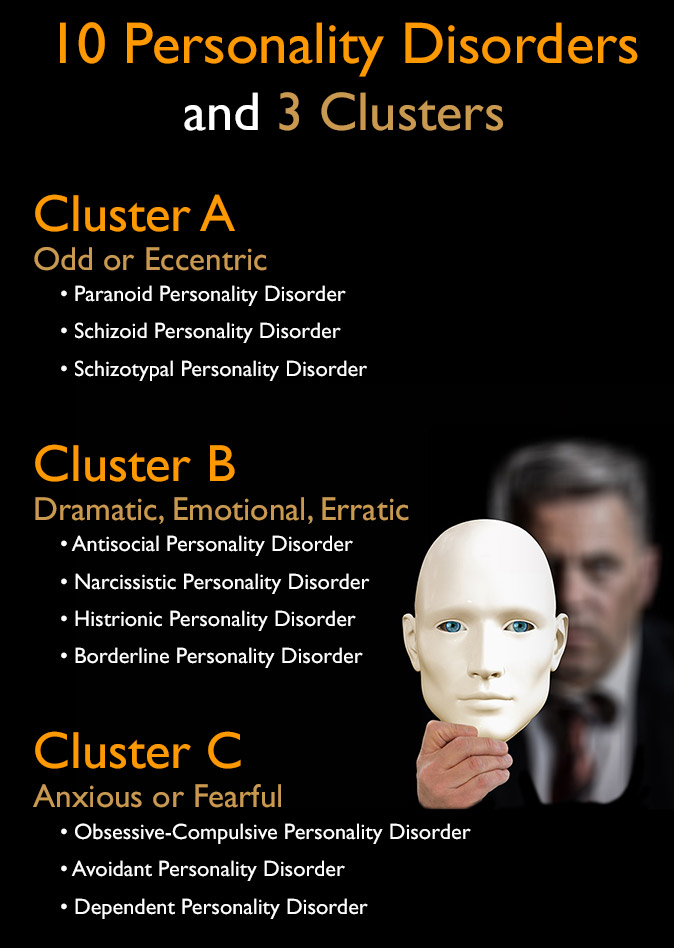
Personality Disorder Treatment
Treatment approaches for personality disorders will vary depending on the severity, duration, and the personality disorder type a person has been diagnosed with.
For some people, talk therapy with a psychologist or psychiatrist combined with antidepressant or mood stabilizing medications can be extremely effective.
Still, successfully treating personality disorders is a process that can take years.
If there are co-occurring illnesses, such as the presence of a substance use disorder and a personality disorder, both disorders need to be addressed at the same time in a dual diagnosis treatment program.
If a patient with a personality disorder receives only mental health or addiction treatment, they are unlikely to have a successful recovery because of the other untreated symptoms.
Considering the 10 personality disorder types, Borderline Personality Disorder and Antisocial Personality Disorder are thought to have the highest rates of substance use disorders.
When using dual diagnosis treatment for personality disorders and addiction, Dialectical Behavioral Therapy has shown to be one of the most effective evidence-based treatment options, along with other forms of cognitive or talk therapy.
In severe cases of personality disorders, a psychiatric team that includes a pharmacist and social worker working together may be necessary for ongoing treatment.
These cases can involve higher levels of anti-psychotic medications, mood stabilizers, or antidepressant and anti-anxiety medications. Hospitalization for treatment is sometimes recommended.
Recovery for severe personality disorder symptoms is possible, but it involves an increased level of participation, dedication, and willingness on the part of the patient.
Personality Disorder FAQs
What are the 10 personality disorder types in the DSM?
The Diagnostic and Statistical Manual of Mental Disorders (DSM-5) recognizes the following 10 personality disorder types:
- Paranoid Personality Disorder
- Schizoid Personality Disorder
- Schizotypal Personality Disorder
- Antisocial Personality Disorder
- Borderline Personality Disorder
- Histrionic Personality Disorder
- Narcissistic Personality Disorder
- Avoidant Personality Disorder
- Dependent Personality Disorder
- Obsessive-Compulsive Personality Disorder (OCPD)
What are the 3 personality disorder clusters in the DSM?
Personality disorders are grouped into 3 distinct clusters based on their traits and characteristics to improve the effectiveness of treatment and diagnosis.
The 3 personality disorder clusters are:
- Cluster A – Odd or Eccentric Disorders
- Cluster B – Dramatic, Emotional, or Erratic Disorders
- Cluster C – Anxious or Fearful Disorders
What are the most common personality disorder types?
Many sources state that obsessive-compulsive personality disorder is the most common, followed by narcissistic and borderline personality disorders, although the sources reference the NESARC study from 2011.
More recent data from Cleveland Clinic in 2022 identifies the most frequently diagnosed personality disorders are borderline personality disorder and antisocial personality disorder.
Why is obsessive-compulsive personality disorder so common?
It’s estimated that obsessive-compulsive personality disorder (OCPD) affects 3% to 8% of adults in the U.S. and it can be caused by:
- Genetics
- Environmental Factors
- Social Adaption Issues
- Lack of Self-Awareness
- Chronic in Nature
- Overlapping Characteristics
Genetics and environmental factors play a major role in developing OCPD. Strict parenting, childhood trauma, and a family history of mental health issues can increase the risk.
Social adaption with a focus on structure and perfectionism in school and work settings often become obsessive or compulsive traits. A lack of awareness that being perfect can be a bad thing exacerbates the condition.
Developing obsessive-compulsive personality disorder at a young age can become chronic and continue into adulthood.
OCPD symptoms and characteristics overlap with anxiety and other mood disorders making it difficult to properly recognize, diagnose, or treat.
How do personality disorders differ from the personality characteristics of typical people?
People with typical personality traits have flexible thoughts and behaviors that can easily adapt to various situations. They have a healthier response to challenges and life stressors without severely disrupting work, school, or relationships.
Individuals with personality disorders have inflexible or rigid thoughts and behaviors that make it difficult to adjust to certain circumstances. Sometimes they don’t perceive their thoughts or behaviors are out of step with others. This can cause them to become isolated or have trouble with work, social interactions, and relationships.
People with which personality disorder type are most likely to seek out treatment on their own?
People with most types of personality disorders often don’t think they have a problem, so they do not seek treatment unless they have severe issues with anxiety or other related conditions.
With that said, people with Histrionic Personality Disorder (HPD) are the most likely to seek help or treatment compared to those with other types of personality disorders.
Individuals with Histrionic Personality Disorder are concerned with their appearance and have a need for attention and validation from others. Ongoing relationship difficulties, negative emotional issues, and the need for approval can be motivating factors for seeking treatment.
Which personality disorder types are most associated with substance use and addiction?
According to an article published on Science Direct, Borderline Personality Disorder and Antisocial Personality Disorder have the highest rates of co-occurring substance use.
For these two types, intense mood swings and aggressive or impulsive behavior are risk factors for substance use, dependence, and addiction. Alcohol and other substances are also used as coping mechanisms for dealing with emotional instability.
Paranoid, Histrionic, and Obsessive-Compulsive Personality Disorders also show elevated rates of alcohol and substance use compared to other types of personality disorders.
Related Posts
- Borderline Personality Disorder and Addiction
Examining the correlation between the 10 types of personality disorders and substance use, one of…
- Borderline Personality Disorder vs Bipolar - Is BPD Worse?
Understanding and distinguishing the differences between Borderline Personality Disorder vs Bipolar Disorder can be difficult…
- Movies About Borderline Personality Disorder BPD
The prevalence of mental health might not be a common topic of discussion, but we…
